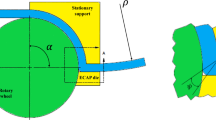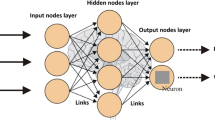Abstract
The cost of injection mould construction depends primarily on the mould complexity. The ability to estimate the mould complexity before releasing the final drawings for construction purposes will greatly help the designers to understand the implications of their design on cost. Mould complexity depends on several factors such as part geometry, parting line, materials, and number of cavities per mould. In most industries, the mould complexity evaluation is performed manually based on past experiences of mould makers. Faced with a shortage of experienced mould makers, there is a pressing need for development of computer-aided tools for mould complexity evaluation. In this study, a neural network-based design tool for computing the mould complexity index, which represents the degree of difficulty of mould manufacturing, has been developed and implemented using a 14-3-1 backpropagation network running on the CNAPS neuro-computer.
Similar content being viewed by others
References
D. V. Rosato and D. V. Rosato,Injection Molding Handbook, Van Nostrand Reinhold, New York, 1986.
Society of Manufacturing Engineers,Tool and Manufacturing Engineers Handbook (TMEH) Vol. 8: Plastic Parts Manufacturing, Society of Manufacturing Engineers, 1996.
I. I. Rubin,Injection Molding Theory and Practice, John Wiley & Sons, New York, 1972.
D. Rosen, “A feature-based representation to support the design process and the manufacturability evaluation of mechanical components”, PhD Dissertation, University of Massachusetts, Amherst, 1992.
C. Poli, P. Dastidar and P. V. Mahajan, “Design for stamping: Part I — Analysis of part attributes that impact die construction costs for metal stampings”,Proceedings, ASME Design Automation Conference, Miami, 1991.
P. V. Mahajan, C. Poli, D. W. Rosen and M. Wozny, “Features and algorithms for tooling cost evaluation for stamping”,Toward World Class Manufacturing,B-17, pp. 37–64, 1993.
M. Vaghul, J. R. Dixon, G. E. Zinsmeister and M. K. Simmons, “Expert systems in a CAD environment: injection molding part design as an example”,Proceedings, ASME International Computers in Engineering Conference,3, pp. 72–78, 1985.
M. K. Simmons and J. R. Dixon, “Experts systems in a CAD environment: injection molding part design as an example”,Proceedings, ASME Computers in Engineering, 1985.
R. K. Irani, B. H. Kim and J. R. Dixon, “Integrating CAE, features, and iterative redesign to automate the design of injection molds”,Proceedings, ASME Computers in Engineering Conference,1, pp. 27–33, 1989.
G. Boothroyd and P. Dewhurst, “Product design for manufacture and assembly”,Manufacturing Engineering, pp. 42–46, April 1988.
A. A. Tseng, J. D. Kaplan, O. B. Arinze and T. J. Zhao, “Knowledge-based mold design for injection molding process”,Proceedings, International Symposium on Intelligent Control, pp. 1199–1204, 1990.
Q. Haiping, Y. Shengjie and R. Xeuyu, “Knowledge-based system for problem diagnosis of injection moulding”,Proceedings, International Conference on Production Research, pp. 1859–1962, 1991.
R. Dighe, M. Jakiela and D. R. Wallace, “Structural synthesis under manufacturability constraints: A CAD system for the design of injection-molded-product housings”,Research in Engineering Design,5, pp. 185–201, 1993.
S. R. Shankar and D. G. Jansen, “A generalized methodology for evaluating manufacturability”, in H. R. Parsaei and W. G. Sullivan (ed.),Concurrent Engineering: Contemporary Issues and Modern Design Tools, Chapman & Hall, London, 1993.
J. W. Priest and J. M. Sanchez, “An empirical methodology for measuring producibility early in product development”,International Journal of Computer Integrated Manufacturing,4(2), 1991.
J. T. Lim, H. M. Rho and K. K. Cho, “A knowledge-based process planning system for injection mold”,Computers in Industrial Engineering,27(1), pp. 96–98, 1994.
N. J. Yannoulakis, S. B. Joshi and R. A. Wysk, “Quantitative measures of manufacturability for rotational parts”,Journal of Engineering for Industry,116, pp. 189–198, May 1994.
J. R. Dixon and C. Poli,Engineering Design and Design for Manufacturing: A Structured Approach, Field Stone Publisher, Massachusetts, 1995.
C. H. Dagli, “Artificial neural networks for intelligent manufacturing”,Transactions on Operational Research, Operational Research Society, Turkey,6, pp. 1–25, 1994.
D. M. Skapura,Building Neural Networks, Addison-Wesley Publishing, New York, 1996.
A. Lapedes and R. Farber, “How neural nets work”,Neural Information Processing Systems, American Institute of Physics, 442 pp., 1988.
Adaptive Solutions, Inc.,CNAPS Back-Propagation Guide: Instruction Manual, Adaptive Solutions, Inc., Oregon, 1993.
C. Poli, P. Dastidar and R. Graves, “Design knowledge acquisition for DFM methodologies”,Research in Engineering Design,4, pp. 131–145, 1992.
J. R. Villegas, “Design for injection molding: a coding system for material”, MS Project Report, Mechanical Engineering Department, University of Massachusetts, Amherst, 1985.
J. Divgi, “The effect of part design attributes on material costs in die casting and tooling costs in die casting and injection molding”, MS Project Report, Mechanical Engineering Department, University of Massachusetts, Amherst, 1986.
R. Fernandez, “The effect of part design on tooling cost in injection molding”, MS Project Report, Mechanical Engineering Department, University of Massachusetts, Amherst, 1985.
DME Company,Molding Systems and Tooling for the 90's, Detroit, 1995.
G. Cybenko, “Approximation by superpositions of a sigmoidal function”,Mathematics of Control, Signals, and System,2(4), pp. 303–314, 1989.
D. G. Bounds and P. J. Lloyd, “A multilayer perceptron network for the diagnosis of low back pain”,Proceedings, IEEE Annual International Conference in Neural Network, San Diego, pp. 481–489, 1988.
R. Hecht-Nielsen, “Kolmogorov's mapping neural network existence theorem”,Proceedings, IEEE Annual International Conference on Neural Networks, San Diego, pp. 11–14, 1987.
Author information
Authors and Affiliations
Rights and permissions
About this article
Cite this article
Raviwongse, R., Allada, V. Artificial neural network based model for computation of injection mould complexity. Int J Adv Manuf Technol 13, 577–586 (1997). https://doi.org/10.1007/BF01176302
Issue Date:
DOI: https://doi.org/10.1007/BF01176302




